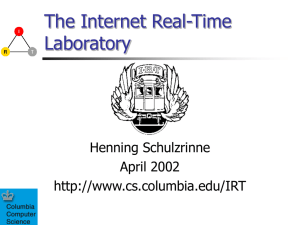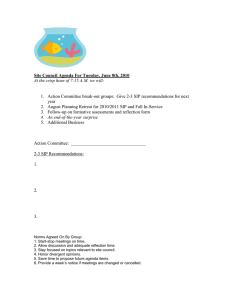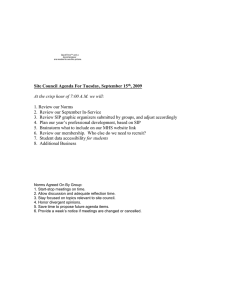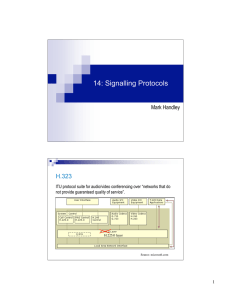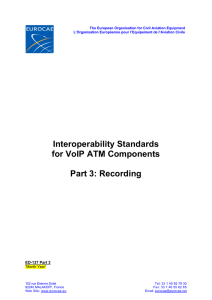The Internet Real-Time Laboratory Henning Schulzrinne CS Seminar
advertisement
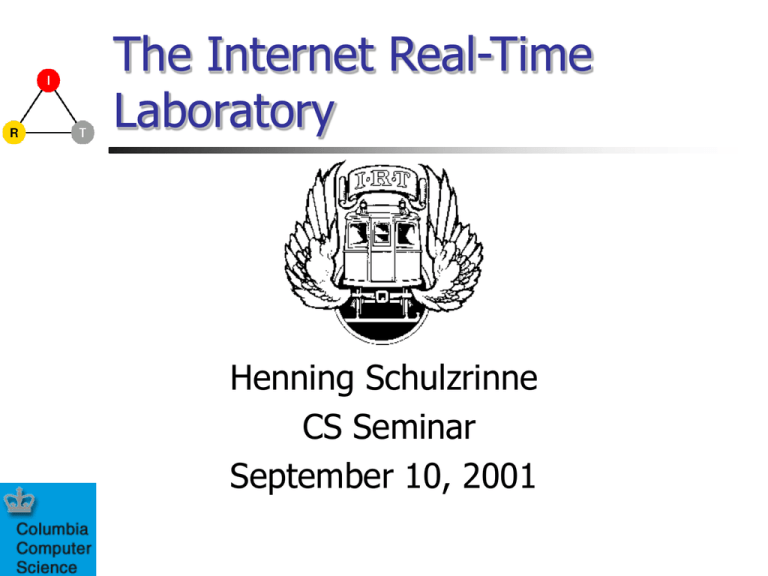
The Internet Real-Time Laboratory Henning Schulzrinne CS Seminar September 10, 2001 Laboratory overview 12 PhDs 4 at IBM, Juniper, Lucent, Telcordia 5 MS 5 visitors (Ericsson, Fujitsu, Mitsubishi, Nokia, U. Coimbra) China, Finland, Greece, India, Japan, Portugal, Spain, Sweden, US, Taiwan IRT topics Internet multimedia protocols and systems Internet telephony and radio (J. Lennox, X. Wu, K. Singh, K. Arabshian, W. Jiang, J. Rosenberg, A. Dutta) Content distribution networks (L. Amini, Y. Nomura) Internet event distribution (P. Koskelainen) Wireless ad-hoc networks (M. Papadopouli, S. Sidiroglou) IRT topics Service discovery (W. Zhao) Quality of service Pricing for adaptive services (X. Wang) Scalable resource reservation protocols (P. Pan) Fair multicast resource allocation (P. Mendes) Internet multimedia Internet telephony = replacing the existing circuit-switched system with Internet-based systems Signaling = setting up calls Quality of service Subjective evaluation of speech codecs, when subjected to packet loss Forward error correction at packet level CINEMA Web interface Administration User configuration Unified Messaging Notify by email rtsp or http Portal Mode 3rd party IpTelSP CINEMA architecture Quicktime SNMP RTSP media server SIP/RTSP Unified messaging SIP conference server Telephone switch T1/E1 SIP proxy, redirect server Web server SQL database RTP/SIP NetMeeting H.323 Software SIP user agent SIPH.323 convertor PSTN interworking PSTN External T1/CAS 1 Call 9397134 Nortel PBX Internal T1/CAS (Ext:7130-7139) 2 Gateway Call 7134 Ethernet 5551212 Regular phone (internal) 5 3 SIP server sipc Bob’s phone SQL database sipd 4 7134 => bob Languages for service creation Traditionally, telecom services created by switch vendors Web model: allow users and organizations to create custom services Two models: sip-cgi and CPL Sip-cgi: cgi scripts for call handling logic Call Processing Language XML-based language <incoming> <address-switch field="origin" subfield="host"> <address subdomain-of="example.com"> <location url="sip:jones@example.com"> <proxy> <busy> <sub ref="voicemail" /> </busy> <noanswer> <sub ref="voicemail" /> </noanswer> <failure> <sub ref="voicemail" /> </failure> </proxy> </location> </address> <otherwise> <sub ref="voicemail" /> </otherwise> </address-switch> </incoming> Mobile ad-hoc networks: 7DS Wireless infrastructure slow to emerge (Metricom , 3G $$$) 802.11b cheap and simple to deploy Mobile devices spread data in densely populated areas (e.g., NYC) 7DS Content-independent: works for any web object Uses standard caching mechanism After 25’, 90% of interested users have 2 data (25 hosts/km ) Also, data upload: 7DS research issues Effects of power conservation, collaboration mechanism, wireless coverage range, density of devices on information dissemination e.g., how fast does information spread in such setting ? what is the average delay that a host experience until it gets the data ? Performance analysis via simulations and diffusion controlled processes theory Mobility for Internet radio p1 S1 S2 p2 M-Proxy Backbone S1 m1 S0 Local Server m1 m2 Local Server RTSP Local Program Ad server RTSP Local Program Ad server (a1,a2) (a3) BS1 BS0 (P1,a1) (P2,a2) m2 BS2 P2,a3 P2,a2 Fairness for multicast Differentiated Service (DiffServ) networks divide traffic into different service quality levels, considering their quality requirements: Intolerant (loss&delay) applications will use DiffServ Premium services, while tolerant applications can use Assured services; Multimedia flows multicast to heterogeneous receivers will use Assured services; Problem: Resources aren’t fairly distributed between flows inside a DiffServ service. Multi-receiver fair allocation Provide fair distribution of Assured services resources between multimedia multicast flows considering: The number of receivers in each multicast flow; A maximal utilization of resources; Differential dropping between flows that overpass their share of service resources; A Multi-Receiver Utilization Maximal fair mechanism (MRUM) is being developed. Quality of service: pricing Bandwidth: decrease of marginal returns adaptive services U1 U2 U3 Cost Budget Bandwidth Bandwidth pricing Congestion pricing See GWB, turnpike, electricity Higher overall utility Prices constant for periods O(min) Auction or tatonnement pricing Charge for usage and reservation
